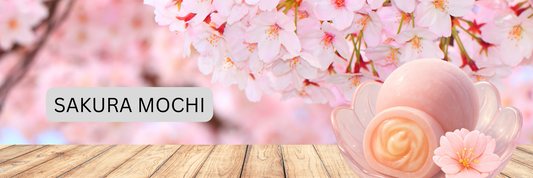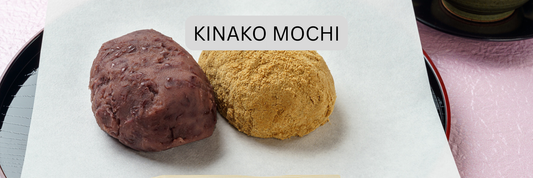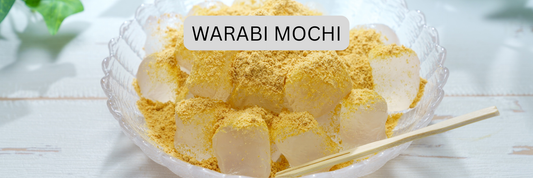Kinako Mochi is one of Japan’s most beloved traditional sweets a perfect harmony of soft, chewy mochi rice cake and the nutty, roasted flavor of kinako (roasted soybean flour). Often enjoyed during the New Year celebrations and at Japanese tea ceremonies, kinako mochi represents simplicity, warmth, and nostalgia in Japanese cuisine.
This humble dessert is not only delicious but also deeply rooted in Japan’s cultural heritage. The toasted soybean powder adds a distinct aroma and a subtle sweetness that perfectly complements the sticky texture of mochi. Whether served plain, with a drizzle of sweet soy syrup (kuromitsu), or paired with matcha tea, kinako mochi continues to be a timeless comfort food loved by both locals and tourists alike.
In this article, we’ll explore everything you need to know about kinako mochi from its origin and meaning, how it’s made, and different variations, to the best ways to enjoy this traditional Japanese treat at home.
-
Warabi Mochi: Japan’s Delicate Jelly Dessert You Must Try
-
Calories in Mochi: The Complete Guide to Nutrition, Health, and Low-Calorie Alternatives
-
Types of Mochi: Complete Guide to Japanese Mochi Varieties
What Is Kinako Mochi?

Kinako mochi (きなこ餅) is a traditional Japanese dessert made by coating chewy mochi (glutinous rice cake) with kinako, a fine powder of roasted soybean flour mixed with sugar.
This simple yet elegant sweet has been enjoyed in Japan for centuries, often served during the New Year celebration (Oshogatsu) or alongside matcha green tea.
The nutty aroma of roasted soy flour perfectly complements the soft, sticky mochi, creating a flavor that is nostalgic, earthy, and mildly sweet a true symbol of Japanese wagashi culture.
Ingredients & Nutritional Value

What You Need to Make Kinako Mochi
- Mochi (fresh, frozen, or kiri mochi – dried rectangular rice cakes)
- Kinako (roasted soybean flour)
- Sugar (white, brown, or cane sugar)
- A pinch of salt (optional)
- Kuromitsu syrup (Japanese black sugar syrup, optional for drizzle)
Nutrition and Benefits
- Kinako is high in plant-based protein, fiber, and B vitamins, making it a nutritious topping for desserts.
- Mochi is gluten-free, made from glutinous rice, and provides long-lasting energy.
- Together, they create a treat that’s both comforting and nutritious when enjoyed in moderation.
How to Make Kinako Mochi (Step-by-Step Recipe)

Ingredients Ratio
- 1 mochi cake
- 1 tablespoon kinako
- 1 tablespoon sugar
- Pinch of salt (optional)
Step 1: Cook the Mochi
There are several ways to prepare mochi:
- Pan-fry or grill method: Place mochi on a non-stick pan and cook both sides until puffed and golden.
- Oven / Broiler method: Place mochi on a lined tray and broil for 5–8 minutes until it expands and softens.
- Boiling method: Drop mochi into boiling water and cook until soft and floaty, then remove immediately.
- Microwave method: Heat mochi for 30–40 seconds with a damp paper towel to prevent drying.
Step 2: Make the Kinako Coating
In a bowl, mix kinako powder with sugar and a pinch of salt. Adjust sweetness to taste.
Step 3: Coat the Mochi
When the mochi is still warm and soft, gently roll or dust it with the kinako-sugar mixture until fully coated.
For extra flavor, drizzle with kuromitsu syrup or maple syrup.
Pro tip: Serve warm mochi hardens as it cools.
Mochi Ice Cream: History, Recipes, Flavors & Everything You Need to Know
Delicious Variations of Kinako Mochi

Popular Styles
- Fried Kinako Mochi: Pan-fry mochi for a crispy outer layer before coating with kinako.
- Kinako Mochi with Anko (Red Bean Paste): Combine kinako with a sweet red bean filling for a daifuku-style dessert.
- Kuromame Kinako Mochi: Made with black soybean flour for a deeper aroma.
- Matcha Kinako Mochi: Mix matcha powder with kinako for a green tea twist.
- Kinako Mochi Ice Cream: Mochi filled with ice cream and coated in kinako powder — a modern favorite.
Compare Kinako Mochi with Similar Japanese Sweets
- Abekawa Mochi: Very similar; typically mochi coated in kinako and sugar, common in Shizuoka Prefecture.
- Warabimochi: A jelly-like dessert made from bracken starch, also dusted with kinako and drizzled with kuromitsu.
- Mizu Shingen Mochi (Raindrop Cake): A clear, water-based dessert topped with kinako and syrup a lighter, modern version.
Tips, Storage, and Common Mistakes

Cooking Tips
- Use mochi while still warm so kinako sticks better.
- If mochi is too sticky, reduce the cooking time or let it rest briefly.
- If mochi becomes hard, reheat it in the microwave for 10–15 seconds with a damp towel.
Storage
- Best enjoyed fresh. Mochi hardens after a few hours.
- Avoid refrigeration; store at room temperature in an airtight container for up to one day.
- For longer storage, freeze uncooked mochi and prepare fresh when needed.
FAQs
Q1. What does kinako mochi taste like?
It has a soft, chewy texture with a nutty, roasted aroma from the soy flour and gentle sweetness from sugar or syrup.
Q2. Is kinako mochi healthy?
Yes, kinako is high in protein and fiber, while mochi is gluten-free. Just watch your sugar intake.
Q3. Can I use mochiko flour to make mochi for kinako mochi?
Absolutely. Mochiko or shiratamako (sweet rice flour) works well for homemade mochi.
Q4. Can I make kinako mochi ahead of time?
You can, but the texture is best when eaten fresh and warm. Mochi becomes tough after cooling.
Q5. What’s the difference between kinako mochi and abekawa mochi?
They’re nearly identical, but abekawa mochi traditionally comes from Shizuoka and is often eaten at festivals.
Q6. Is kinako mochi gluten-free?
Yes. Both rice and soybeans are naturally gluten-free, making this dessert suitable for gluten-sensitive diets.
Q7. Can I make sugar-free kinako mochi?
Yes, use alternative sweeteners like monk fruit or erythritol instead of sugar.
Cultural Significance of Kinako Mochi
- Kinako has been used in Japan since the Heian period, valued for its rich flavor and nutrition.
- Mochi represents prosperity and good fortune, making it a common food during New Year celebrations.
- Today, kinako mochi appears not only in homes but also in Japanese cafés, bento shops, and wagashi stores across the world.
Conclusion
Simple, wholesome, and deeply traditional kinako mochi perfectly captures the harmony of Japanese minimalism in dessert form.
Whether you enjoy it warm with kuromitsu syrup or as a modern ice cream twist, this treat brings the comforting taste of roasted soy and chewy rice together in one bite.







